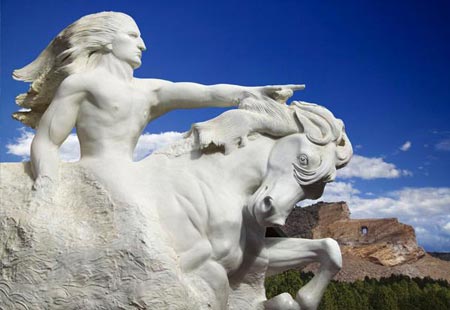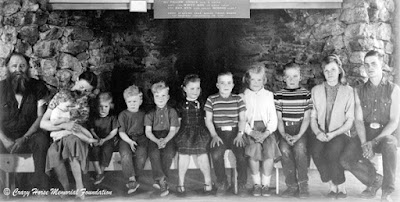Date of Visit August 13, 2015
Market For Elephants: Nothing for elephants to graze on till south of the mountains, and winters are way too arduous.
Crazy Horse Memorial
The second major attraction in the Black Hills is the Crazy Horse Memorial. Crazy Horse was a Lakota hero born about 1840 near the Belle Forche River. As a young man he gained his reputation as both a fighter and leader raiding the Crows and Shoshoni.
In 1930 a group of aging warriors met Elinor Hinman of the Nebraska State Historical society and told stories about his fighting and leadership style. He Dog, a longtime friend, corrected the impression whites got from his name that he was a berserker.
“Crazy Horse always stuck close to his bow or rifle. He always tried to kill as many as possible of the enemy without losing his own men.”
This was important since by the 1860’s he was an accepted leader, but his only authority was his reputation as a warrior and a belief in his personal magic. Losing men would cost him prestige.
He Dog also said “All the times I was in
fights with Crazy Horse in critical moments of the fight Crazy Horse would always jump off his horse to fire. He is the only Indian I ever knew who did that often. He wanted to be sure that he hit what he aimed at. That is the kind of fighter he was. He didn’t like to start a battle unless he had it all planned out in his head and knew he was going to win.”
 |
| He-Dog |
They recounted an 1861 battle. Crazy Horse was riding with a mixed Cheyenne and Lakota band to raid a Shoshoni camp. They took off with a number of Shoshoni horses but their success made them too slow. Crazy Horse and his brother Little Hawk fell back as a rear guard.
According to another friend Short Buffalo, Crazy Horse leaped down and dunked behind a rock fired a half dozen arrows and then jumped back on his horse.
 |
| Short Buffalo |
“Crazy Horse’s pony gave out and the younger brother, who did not want to leave him, turned his own pony loose. Two of the enemy, mounted, appeared before them for single combat. Crazy Horse said to his brother, ‘Take care of yourself-I’ll do the fancy stunt.”
Crazy Horse faked right, jumped left, grabbed the Shoshoni’s leg and yanked him off his horse. Crazy Horse saw his brother had killed the other attacker with an arrow so they mounted the fresher horses and escaped, pausing to take a scalp.
 |
| A staged Lakota war party. |
A young man but already an experienced leader he was nearby when Brave Bear was killed.
He was one of the first to see the camp destroyed by General Harney.
He saw for the first time a Sioux camp in Sioux territory destroyed the bodies butchered.
He saw for the first time a Sioux camp in Sioux territory destroyed the bodies butchered.
After all this it is not surprising he was among the leaders who refused to take part in any negotiations.
During the first part of the American Civil War he rode with the Cheyenne raiders.
 |
| Ambushing the firewood party |
The commander of Fort Kearney was shaken. He moved the women into the armory and planted charges to blow it up if the fort was taken.
However the attacking warriors had taken many casualties and were sure the whites would have to leave them alone after so many defeats. When the army broke up Crazy Horse took a group to raid the Crows.
During the semi-truce with the whites from of 1869 to 1873 he was mostly involved in hunting and raiding. He had followers but was never formally named a chief.
Crazy Horse’s most famous campaign was with Sitting Bull in 1876. To the army summer was a time to destroy the non-treaty tribes. They failed to realize a number of families had left the reservations and joined the hostiles for summer hunting.
Crazy Horse was camped on Rosebud Creek when General Crook attacked.
According to Short Buffalo, “The Crows, Shoshones and Crook together made up a strong force. In the Rosebud fight the soldiers first got the Sioux and the Cheyennes on the run. Crazy Horse… rallied the Sioux, turned the charge and got the soldiers on the run.”
However the camp and all the supplies they had prepared for winter were burned.
“Six days after the Rosebud fight, Custer ran into us (at the Little Big Horn valley.) In this Custer fight I was helping fight (Major) Reno and never noticed Custer coming. We had Reno’s men on the run across the creek when Crazy Horse rode up with his men.”
“Too Late! You’ve missed the fight!” we called out to him.
“Sorry to miss this fight!” he laughed. “But there’s a good fight coming over the hill.”
“I looked where he pointed and saw Custer and his blue coats pouring over the hill. I thought there were a million of them.”
“That’s where the big fight is going to be,” said Crazy Horse. “We’ll not miss that one.”
“He was not a bit excited;” said Short Buffalo. “He wheeled and rode down the river… He was the first man across the river. I saw he had the business well in hand.”
While Short Buffalo held Reno’s unit on a bluff well away from the camp, Crazy Horse and Gall were able to surround the units under Custer. Some Indian witnesses said the larger Indian forces seemed to herd the blue coats on to a hill were they were all killed.
One eyewitness description of Custer’s death was repeated by Sitting Bull who was not there to a reporter in 1877.
“Up there where the last fight took place, where the last stand was made, the Long Hair stood like a sheaf of corn with all the ears fallen around him…
He killed a man when he fell. He laughed.”
“You mean he cried out” asked the reporter?
“No,” said Sitting Bull “he laughed. He had fired his last shot.”
The next morning General Terry joined Major Reno and as Short Buffalo said “The Indians quit and went away.”
“There had been three armies after us – Crook, Custer and Bear Coat (Terry). If all three forces had struck together, it might have been a different story. But each struck separately.”
When Sitting Bull’s camp broke up, many people returned to the reservations for the winter, while Sitting Bull went north into the Big Horn, mountains.
Crazy Horse and maybe six hundred people reached the Black Hills in August where he intended to harass the prospectors. He had so much trouble getting his exhausted warriors interested He Dog said he would go out by himself, coming back with captured mules loaded with supplies.
His remaining friends were worried by his new recklessness.
In September about 36 families were camped near Slim Buttes on their way back to the reservation when Col. Anson Mills stumbled on them and attacked with 150 men.
The Sioux escaped to hills and sent to Crazy Horse for help. While Mills and his men stopped to gorge on the Indians dried meat Crazy Horse attacked but was held off by new carbines.
 |
| Slim Buttes |
 |
| Crooks Army on Winter March |
He attempted to surrender at a fort on the Tongue River to Col Nelson Miles, but his envoys were shot down by Crow scouts.
Many families wanted to leave him and go to the reservations. Against Sioux tradition he resorted to force to hold his band of two thousand together. He simply would not risk anyone being shot out of hand.
Many families wanted to leave him and go to the reservations. Against Sioux tradition he resorted to force to hold his band of two thousand together. He simply would not risk anyone being shot out of hand.
Starting on New Year’s Day, 1877, there was a running battle lasting an entire week as the last of his warriors allowed the women and children to escape.
Sitting Bull visited him when Miles retired to his fort for the terrible winter and ask him to come to Canada with him but he refused.
 |
Crazy Horse's Band marches to Surrender |
The chiefs on the reservation only held authority if they were appointed to distribute supplies by the white officials. Red Cloud, Spotted Tail and several others were competing for this post.
Crook, Spotted Tail, and Red Cloud tried to convince Crazy Horse to come
with them to Washington so he could he put his request to the president. Actually to present the famous Crazy Horse as a prisoner in Washington would redeem the army and Crook in the press.
 |
| General Crook |
Tension rose as they realized many Lakota saw Crazy Horse as the last great hero. He was in a position to set off a riot or escape.
Then Crazy Horse interfered in a plan to recruit Lakota to serve as army scouts fearing they would be used against other Lakota.
Crazy Horse must have known he was about to be arrested because he left with his new wife suddenly and out distanced the Indian police and several troops of cavalry that followed him. Once he reached another agency he insisted he had just moved to get his wife better medical treatment and returned quietly.
When He Dog got the news he rushed to Fort Robinson. All he could do was shake his old friends hand and whisper that “you are going into a dangerous place.”
“Soon after Crazy Horse had gone into the jail, a noise began in there. Crazy Horse had a revolver with him and tried to draw it, but it was taken away from him."
"Then he drew his knife. American Horse and Red Cloud shouted to their men, 'Shoot to kill!' The white sentry who was on guard outside the jail ran in behind Crazy Horse as he was fighting with the Indian police and lunged-twice- with his bayonet,"
When He Dog was allowed to approach he saw both the bayonet and knife were red. He lifted his friend and carried him inside.
Crazy Horse died the next morning, with his father by his side.
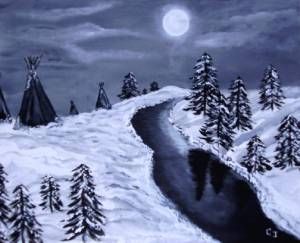 |
| Winter in South Dakota |
Among messages of thanks was a letter from Chief Henry Standing Bear, school teacher and leader of the Council of American Indians. He proposed a memorial fund, raising funds among Native Americans only, to pay for carving another mountain.
Borglum and Standing Bear met but it was clear that between the depression and Borglum’s many projects it was impractical at that time.
In 1939 Standing Bear, now living on the Pine Ridge Indian Reservation,
contacted Korczak Ziolkowski, an established sculptor, who had worked shortly for Borglum. He explained “My fellow Chiefs and I would like the White Man to know the Red Man had great heroes, too.”
 |
| Zilokowski and Standing Bear |
Ziolkowski was interested but even after several meetings with Standing Bear he was unsure of working on a mountain.
 |
| Noah Wesbster |
Then he served three years in the army.
Finally in 1946 he decided to go for it.
Crazy Horse was chosen by a council of chiefs as the subject. He was still considered a hero for never having signed a peace treaty 'taken a pen' and leading campaigns to protect his people until starvation was certain. Also he never had a photo taken so Ziolkowski had to work from descriptions. He did know that Crazy Horse had a vision as a young man that told him to never wear war paint or a war bonnet.
Ziolkowski and Standing Bear chose an unnamed mountain to work on.
They named it Thunderhead Mountain because of the clouds overhead. It was also in keeping with the Lakota belief in the thunder beings that live over the Black Mountains.
Crazy Horse was chosen by a council of chiefs as the subject. He was still considered a hero for never having signed a peace treaty 'taken a pen' and leading campaigns to protect his people until starvation was certain. Also he never had a photo taken so Ziolkowski had to work from descriptions. He did know that Crazy Horse had a vision as a young man that told him to never wear war paint or a war bonnet.
Ziolkowski and Standing Bear chose an unnamed mountain to work on.
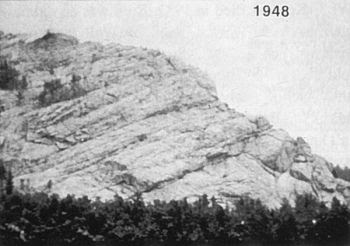 |
Thunderhead Mountain |
The design of the statue was based on a moment, following the little
Bighorn, when Crazy Horse and his band were being followed by cavalry. A white trader asked Crazy Horse were his lands were now. The warrior pointed toward the horizon and said “My lands are where my dead lie buried. “
Korczak took possession of the mountain by filing a mining claim which required he perform $100 of assay work a year.
Careful study made him decide to expand the project from the top one hundred feet of the mountain to a statute in the round to be 563 feet tall and 641 feet long.
Korczak started by climbing to the top of the mountain by rope and drilled
holes for blasts by hand chisel. In his first full year (1949) he dynamited over 97,000 tons of rock.
Later he cut a flight of 741 stairs to move a jack hammer to the top with
pipes running from the ground for compressed air.
From 1950-1955 still working alone he blasted out the rough outline of the head removing 630 thousand tons of rock.
Since he needed to clear the loose rock from the arm from 1955-56 he built
a full road so a bull dozer could be driven up to clear the stone off the arm. This also allowed equipment to be carried up and down in a jeep.
Work has continued each summer season ever since. Foot by foot thousands of tons
of rocks were removed from the head, arm and the tunnel between the arm and the body.
The last detail work on the face was dedicated in 1998.
a full road so a bull dozer could be driven up to clear the stone off the arm. This also allowed equipment to be carried up and down in a jeep.
Work has continued each summer season ever since. Foot by foot thousands of tons
of rocks were removed from the head, arm and the tunnel between the arm and the body.
The last detail work on the face was dedicated in 1998.
Korczak died in 1982 his wife and partner 2014. However six of their children and grandchildren continue the project with detailed guide lines from the sculptor. One understands what a planner he was when you see the tomb and coffin he made for himself.
It was decided from the beginning that no government funds would be sought. The Federal government granted the Crazy Horse Foundation nonprofit status.
Funding is primarily raised by ticket sales, private donations, and the sale of souvenirs. The public explanation of this was Korczak’s faith in the private enterprise system and his view of how delays and confusion in public funding hurt the Mount Rushmore project.
There are some viewers who feel this was designed to have this program free of government oversight providing lifetime employment for family members who desire it.
It did allow the Foundation thru a special arrangment to purchase state owned lands and trade them for federal lands including Thunderhead Mountain.
It did allow the Foundation thru a special arrangment to purchase state owned lands and trade them for federal lands including Thunderhead Mountain.
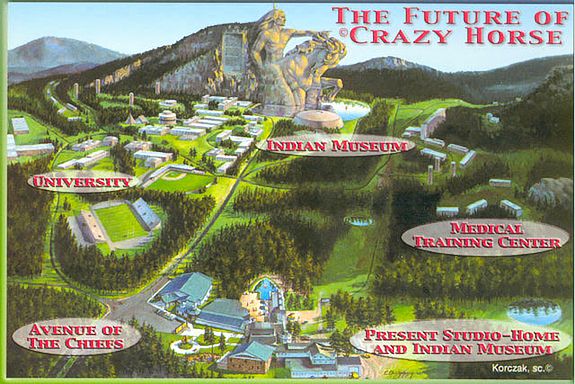 The Foundation has also pledged itself to creating the Indian Museum of North America, a cultural center and the Indian University of North America. The Museum has an excellent start with plans for expansions, when space is available near the statue.
The Foundation has also pledged itself to creating the Indian Museum of North America, a cultural center and the Indian University of North America. The Museum has an excellent start with plans for expansions, when space is available near the statue. The Indian University of North America started in 2010 as a summer school being run by the University of South Dakota.
MY VISIT: Admission is high but well worth it. In Sept of 2015 it was $11 per-person or $28 a carload.
The introduction film was kind of, well blah, not loaded with facts about the project or Crazy Horse.
The museum really held my attention. It does not have any technically complex displays such as films, recordings or animatronic figures. But it has a lot of beautiful, real looking items from (according to the labels) private and family collections. It is also inclusive spreading from the western plaines tribes out to the east coast and up to the Alaskan natives.
When I was there a bazaar of Indian crafts persons were doing business. I understand that the crafts center is a regular feature.
 |
| Paderewski |
Attached to the Indian museum are Korczak’s log cabin home, studio and workshop. Among pieces on display are a bronze of Chief Henry Standing Bear and his bust of the pianist Paderewski which won him first prize at the 1939 world’s fair. This award may have decided Chief Standing Bear to contact him as well as his short experience with Borglum.
There is a standard snack shop but also the Laughing Water Restaurant which offers both standard and special dishes such as the buffalo stew with Indian bread.
The actual statue can be seen clearly from everywhere , parking lot, museum, restaurant, but I enjoyed sitting on the veranda in the shade and studying it for a while comparing the fir covered mountains to the now bare Thunderhead. A medium pair of binoculars will let you study the large cuts.
If the time is right, for another small fee, you can make a van trip to the top of the arm. It’s a little bumpy and hot at the top but the view, never has a 600 foot mountain felt taller.
Again if lucky you may be there for one of the Native
American performances. I was able to watch three young ladies work from simple to complex hoop dances. Check
If possible check the website to see if van rides and the after dark Laser-Light show are being offered.
Geek Factor: Folks with an interest in weapons will want to check out an edited version of the tv show Deadliest Warrior: Crazy Horse Vs Pancho Villa. Only for the strong of stomach.
In 1955 the film Crazy Horse tried to tell his story totally from the Native American point of view but unfortunatly with white actors.
Additional Resources
In 1955 the film Crazy Horse tried to tell his story totally from the Native American point of view but unfortunatly with white actors.
Additional Resources
Ambrose, Stephen. Crazy Horse and Custer: The Parallel Lives of Two American Warriors Open Road Media. Kindle Edition.
DeWall, Robb Korczak: Storyteller in Stone, Korcza Crazy Horse Memorial Heritage, Inc, S.D. 1986
Oglala Sources on the Life of Crazy Horse, Interviews Given to Eleanor H. Hinman. www.nebraskahistory.org/publish/publicat/history/full-text/NH1976Oglala_Sources.pdf
Ostler, Jeffrey. The Lakotas and the Black Hills: The Struggle for Sacred Ground (The Penguin Library of American Indian History) Penguin Publishing Group. Kindle Edition.
Shaff, Howard, Six Wars at a Time, the life and times of Gutzon Borglum, Permelia Publishing, Conn, I985. ISBN 0931170265





